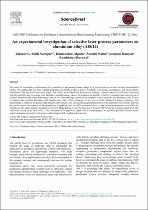 ResearchSpace
ResearchSpace
An experimental investigation of selective laser process parameters on aluminium alloy (AlSi12)
JavaScript is disabled for your browser. Some features of this site may not work without it.
- ResearchSpace
- →
- Research Publications/Outputs
- →
- Journal Articles
- →
- View Item
| dc.contributor.author |
Nzengue, AGB

|
|
| dc.contributor.author |
Mpofu, K

|
|
| dc.contributor.author |
Mathe, Ntombizodwa R

|
|
| dc.contributor.author |
Daniyan, I

|
|
| dc.contributor.author |
Muvunzi, Ra

|
|
| dc.date.accessioned | 2024-01-11T08:30:40Z | |
| dc.date.available | 2024-01-11T08:30:40Z | |
| dc.date.issued | 2023-07 | |
| dc.identifier.citation | Nzengue, A., Mpofu, K., Mathe, N.R., Daniyan, I. & Muvunzi, R. 2023. An experimental investigation of selective laser process parameters on aluminium alloy (AlSi12). http://hdl.handle.net/10204/13494 . | en_ZA |
| dc.identifier.issn | 2212-8271 | |
| dc.identifier.uri | https://doi.org/10.1016/j.procir.2023.06.109 | |
| dc.identifier.uri | http://hdl.handle.net/10204/13494 | |
| dc.description.abstract | The chase for sustainable manufacturing that contributes to addressing climate change is of research interest across scientists and industrial sectors. The lightweight and high strength properties of aluminium alloys foster sustainable cost, energy consumption and environmental friendliness. This has made aluminium alloys such AlSi12 to be adopted in the transport industry. However, there are difficulties associated with the material when processing with subtractive manufacturing systems. To hardness the benefits of AlSi12, researchers advocate the use of Additive Manufacturing (AM) technologies. One of the AM technology considered in this paper is the Selecting Laser Melting (SLM). SLM is a technique that presents advantages and disadvantages. One of the advantages of the process is the freedom of design complexity. The disadvantage is related to the process that influence the built part. The rapid cooling and heating motion of the interaction between the laser and the powder impact the structure of the printed part. Considering that the SLM process involves a range of process parameters that affect the printed part, this paper employs the Response Surface Methodology to vary the laser power from 50-300 W and the scanning speed from 500-2500 mm/s during the SLM of AlSi12. The result yielded the significant impact of low scanning speed on a printed specimen. Further studies entail conducting parametric optimisation and evaluation of the mechanical properties. | en_US |
| dc.format | Fulltext | en_US |
| dc.language.iso | en | en_US |
| dc.relation.uri | https://www.sciencedirect.com/science/article/pii/S2212827123003360 | en_US |
| dc.source | Procedia CIRP, 118 | en_US |
| dc.subject | Aluminium alloys | en_US |
| dc.subject | Process parameters | en_US |
| dc.subject | Selecting Laser Melting | en_US |
| dc.subject | SLM | en_US |
| dc.subject | Sustainable manufacturing | en_US |
| dc.title | An experimental investigation of selective laser process parameters on aluminium alloy (AlSi12) | en_US |
| dc.type | Conference Presentation | en_US |
| dc.description.pages | 638-642 | en_US |
| dc.description.note | © 2023 The Authors. Published by Elsevier B.V. This is an open access article under the CC BY-NC-ND license (https://creativecommons.org/licenses/by-nc-nd/4.0). | en_US |
| dc.description.cluster | Manufacturing | en_US |
| dc.description.impactarea | Laser Enabled Manufacturing | en_US |
| dc.identifier.apacitation | Nzengue, A., Mpofu, K., Mathe, N. R., Daniyan, I., & Muvunzi, R. (2023). An experimental investigation of selective laser process parameters on aluminium alloy (AlSi12). http://hdl.handle.net/10204/13494 | en_ZA |
| dc.identifier.chicagocitation | Nzengue, AGB, K Mpofu, Ntombizodwa R Mathe, I Daniyan, and Ra Muvunzi. "An experimental investigation of selective laser process parameters on aluminium alloy (AlSi12)." <i>Procedia CIRP, 118</i> (2023): http://hdl.handle.net/10204/13494 | en_ZA |
| dc.identifier.vancouvercitation | Nzengue A, Mpofu K, Mathe NR, Daniyan I, Muvunzi R, An experimental investigation of selective laser process parameters on aluminium alloy (AlSi12); 2023. http://hdl.handle.net/10204/13494 . | en_ZA |
| dc.identifier.ris | TY - Conference Presentation AU - Nzengue, AGB AU - Mpofu, K AU - Mathe, Ntombizodwa R AU - Daniyan, I AU - Muvunzi, Ra AB - The chase for sustainable manufacturing that contributes to addressing climate change is of research interest across scientists and industrial sectors. The lightweight and high strength properties of aluminium alloys foster sustainable cost, energy consumption and environmental friendliness. This has made aluminium alloys such AlSi12 to be adopted in the transport industry. However, there are difficulties associated with the material when processing with subtractive manufacturing systems. To hardness the benefits of AlSi12, researchers advocate the use of Additive Manufacturing (AM) technologies. One of the AM technology considered in this paper is the Selecting Laser Melting (SLM). SLM is a technique that presents advantages and disadvantages. One of the advantages of the process is the freedom of design complexity. The disadvantage is related to the process that influence the built part. The rapid cooling and heating motion of the interaction between the laser and the powder impact the structure of the printed part. Considering that the SLM process involves a range of process parameters that affect the printed part, this paper employs the Response Surface Methodology to vary the laser power from 50-300 W and the scanning speed from 500-2500 mm/s during the SLM of AlSi12. The result yielded the significant impact of low scanning speed on a printed specimen. Further studies entail conducting parametric optimisation and evaluation of the mechanical properties. DA - 2023-07 DB - ResearchSpace DP - CSIR J1 - Procedia CIRP, 118 KW - Aluminium alloys KW - Process parameters KW - Selecting Laser Melting KW - SLM KW - Sustainable manufacturing LK - https://researchspace.csir.co.za PY - 2023 SM - 2212-8271 T1 - An experimental investigation of selective laser process parameters on aluminium alloy (AlSi12) TI - An experimental investigation of selective laser process parameters on aluminium alloy (AlSi12) UR - http://hdl.handle.net/10204/13494 ER - | en_ZA |
| dc.identifier.worklist | 27306 | en_US |





